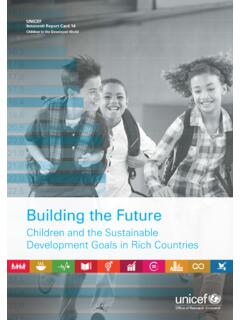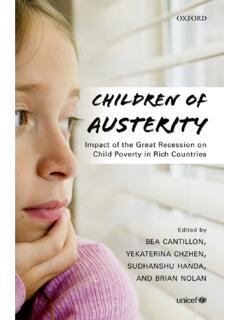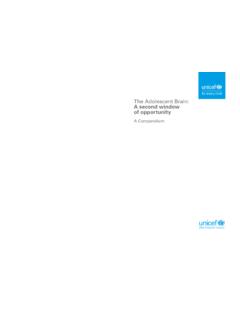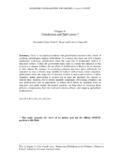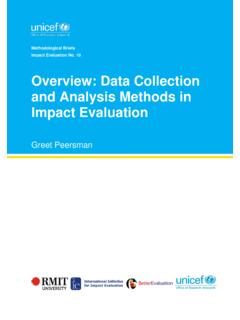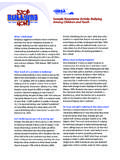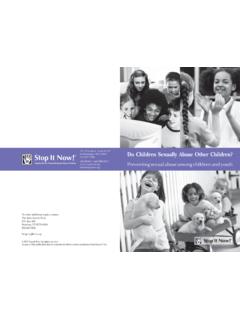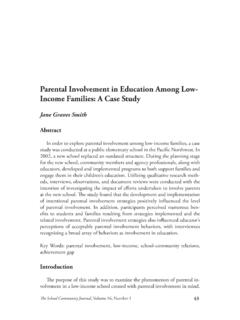Transcription of Prevalence and Correlates of Food Insecurity among ...
1 1 Prevalence and Correlates of food Insecurity among children across the GlobeAudrey L. Pereira, Sudhanshu Handa, and Goran HolmqvistOffice of Research - Innocenti Working Paper WP-2017-09 | June 20172 INNOCENTI WORKING PAPERSUNICEF Office of Research Working Papers are intended to disseminate initial research contributions within the programme of work, addressing social, economic and institutional aspects of the realization of the human rights of findings, interpretations and conclusions expressed in this paper are those of the authors and do not necessarily reflect the policies or views of paper has been peer reviewed both externally and within text has not been edited to official publications standards and UNICEF accepts no responsibility for from this publication may be freely reproduced with due acknowledgement. Requests to utilize larger portions or the full publication should be addressed to the Communication Unit at: readers wishing to cite this document, we suggest the following form:Pereira, , Handa, S.
2 And Holmqvist, G. Prevalence and Correlates of food Insecurity among children Across the Globe, Innocenti Working Paper 2017-09, UNICEF Office of Research, Florence. 2017 United Nations children s Fund (UNICEF)eISSN: 2520-6796 3 THE UNICEF OFFICE OF RESEARCH INNOCENTIThe Office of Research Innocenti is UNICEF s dedicated research centre. It undertakes research on emerging or current issues in order to inform the strategic directions, policies and programmes of UNICEF and its partners, shape global debates on child rights and development, and inform the global research and policy agenda for all children , and particularly for the most produced by the Office are contributions to a global debate on children and may not necessarily reflect UNICEF policies or approaches. The views expressed are those of the Office of Research Innocenti receives financial support from the Government of Italy, while funding for specific projects is also provided by other governments, international institutions and private sources, including UNICEF National further information and to download or order this and other publications, please visit the website at Correspondence should be addressed to:UNICEF Office of Research - InnocentiPiazza SS.
3 Annunziata, 1250122 Florence, ItalyTel: (+39) 055 20 330 Fax: (+39) 055 2033 AND Correlates OF food Insecurity among children ACROSS THE GLOBEA udrey L. Pereira1, Sudhanshu Handa2, and Goran Holmqvist11 UNICEF Office of Research Innocenti, Florence, ITALY2 Department of Public Policy, University of North Carolina at Chapel Hill, USAC orresponding author is: Abstract: Target of the Sustainable Development Goals calls to end hunger, in all its forms, by 2030. Measuring food security among children under age 15, who represent a quarter of the world s population, remains a challenge and is unfeasible for global monitoring. The SDG framework has agreed to use the food Insecurity Experience Scale (FIES) to measure moderate and severe food Insecurity . The FIES is an experience-based metric that reports food -related behaviours on the inability to access food due to resource constraints.
4 We present the first global estimates of the share and number of children below age 15, who live with a respondent who is food insecure. Methodology: Using nationally-representative data from the Gallup World Poll (GWP) survey in 2014-15, we provide the first estimates of food Insecurity among households with children under age 15, globally, and by region. In addition, we test the robustness of the FIES against 1) the GWP food Insecurity indicator; 2) monetary poverty; and 3) a measure of well-being the Negative Experience Index to understand how well the FIES captures different aspects of food Insecurity . Finally, we explore trends in per capita income as a determinant of food security (2006-2015), to observe how this relationship fluctuated during the Great : among 147 countries and four territories, 41% of children under age 15 live with a respondent who is moderately or severely food insecure, 19% live with a respondent who is severely food insecure, and 45% live with a respondent who reported not having enough money to buy food in the previous 12 months.
5 These estimates translate into roughly 605 million, 260 million and 688 million children under age 15, respectively. The relationship between food Insecurity and poverty, and well-being varies by region, demonstrating that definitions of food Insecurity depend on regional context, and encompass more than monetary poverty alone. Finally, correlations of food Insecurity and income per capita between 2006 and 2015, show that some regions were harder hit by the shocks in food prices and the Great Recession than others. Conclusions: Our estimates are the first to quantify the extent of food Insecurity among households with children across countries and ideally, will encourage and provide motivation for continued global efforts to address this issue and monitor progress towards SDGs. In addition, further research on how food Insecurity differs between children and adults will be important for future efforts to address and reduce child hunger.
6 Acknowledgements: The authors thank Gallup for the data, without which, this analysis and manuscript would not have been possible. We also thank the Voices of the Hungry project of the food and Agriculture Organization of the United Nations (FAO) for funding this project and the license to use the GWP data. Our thanks go to Terri Ballard, Andrew Rzepa and Sara Viviani for helpful technical advice throughout this project, Laura Meucci for grant administration, and Amber Peterman for useful comments and editorial assistance. 5 TABLE OF CONTENTS1. INTRODUCTION ..62. DATA AND METHODOLOGY ..72a. Gallup World Poll ..72b. The Voices of the Hungry (VoH) project and food Insecurity Experience Scale (FIES) ..82c. Methodology ..93. RESULTS ..103a. Descriptive statistics of Comparing different measures of food Insecurity ..113c. How do food Insecurity measures compare with monetary and non-monetary measures of well-being?
7 133d. Prevalence and burden of food Insecurity by region ..143e. How do the FIES-M+ and GWP indicator estimates compare to national data? ..153f. Income as a determinant of food security over time (2006-2015)..174. DISCUSSION AND CONCLUSION ..195. REFERENCES ..21 APPENDIX ..23 APPENDIX 1. Regional groupings of countries/territories included in analysis (where data on households with at least one child under age 15 was available) ..23 APPENDIX 2: food Insecurity Prevalence by region and country in 2014-15, among all households, and households with children under 15 years ..24 APPENDIX 3: Weighted means of key variables for all countries by year ..35 APPENDIX 4: Notes on sources and calculations ..376 Prevalence and Correlates of food Insecurity among children across the GlobeInnocenti Working Paper 2017-09 1. INTRODUCTIONTo end hunger and achieve food security for all is a prominent target under the Sustainable Development Goals (Target ) (United Nations Economic and Social Council, 2016).
8 From this global commitment stems the challenging task of estimating national Prevalence rates of food Insecurity ; estimates that should be comparable across countries and population groups, while also permitting tracking of progress over time. Holistic measures of food Insecurity would ideally assess a broad range of causes, including food utilization or food quality, and outcomes such as poor health or shame associated with food challenges. More specifically, definitions and measures of food Insecurity are beginning to move away from focusing on siloes of access, availability and utilization, and consider factors such as food sufficiency, nutrient adequacy, cultural acceptability, safety, and certainty and stability of foods (Coates, 2013). Accordingly, using indices or scales has become a more common approach to capturing these different dimensions; leading to a more comprehensive understanding of food Insecurity .
9 Finally, because food Insecurity risks vary at the individual, household and community levels in different settings, developing a method to comparably measure food Insecurity over groups and across time, remains a challenge. In the global SDG indicators framework, it has been agreed to use the food Insecurity Experience Scale (FIES) to estimate the Prevalence of moderate and severe food 2013, the food and Agricultural Organization of the United Nations (FAO) launched the Voices of the Hungry (VoH) project to monitor food Insecurity worldwide. The FIES was developed not only to measure the severity of food Insecurity at the individual or household level, but also to provide comparisons of food Insecurity across countries and over time. The FIES is based on three existing tools that are used to measure food Insecurity in household-based surveys: the US Household food Security Survey; the Household food Insecurity Access Scale; and the Latin American and Caribbean food Security Scale (Escalal Latinoamericana y Caribena de Seguridad Alimentaria ELSCA), and is an experience-based metric that reports food -related behaviours on the inability to access food due to resource constraints (Ballard, Kepple and Cafiero, 2013).
10 In 2014, the FIES was introduced in the Gallup World Poll (GWP), a large-scale population-based household survey, covering nearly all countries of the world and with data collected annually. For the SDGs, it is of particular interest, as it is one of very few indicators that may deliver universal country coverage with annual updates, while reflecting a fundamental quality of human life with strong links to various dimensions of well-being. However, a severe limitation of these FIES estimates is that because we are using the GWP, they are derived from responses from individuals aged 15 and over, leaving out individual-level responses from the world s children below age 15. The FIES module itself, however, can be applied to any population group and at the individual or household below age 15 constitute more than a fourth of the world s population (World Bank, 2015).

